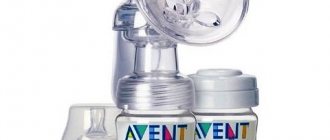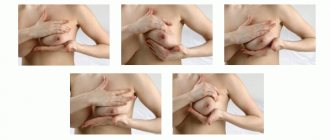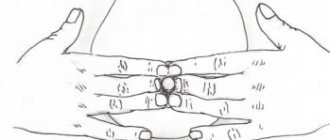Previously, breastfeeding mothers used to express milk manually, but now everything has changed, and special devices are available to women living in the modern world. In this article you will learn about how to properly express breast milk with a breast pump, how often to do it, and what are the benefits of this process. Should we always listen to the advice of our mothers about an “artificial” way to empty our breasts?
For new mothers, breastfeeding usually raises many questions. And one of the most pressing topics is how to express breast milk using a breast pump. First of all, they are interested in when it is necessary to express milk. Usually, the older generation intimidates inexperienced nurses with stories that if the breasts are not emptied, the milk will “burn out.” We will also answer the question of whether it is painful to express the mammary glands, and whether there is an alternative.
Why choose a mechanical breast pump
The so-called manual devices designed for expressing breast milk are divided into 2 categories - syringe and pump (there is also a variation with a pear). The latest devices are quite inconvenient to use.
Therefore, if you are thinking about purchasing a breast pump, it is better to choose the first option. Compared to a device with a pump, this model is more convenient, and compared to an electric breast pump, it is safer. The only negative is that you need to devote a lot of time to the pumping process (up to 15-20 minutes per breast).
Types of breast pumps
Electrical Products
They create a vacuum using a motor and express milk quickly and painlessly. No effort is required and your hands remain free. The main thing is to place the shield correctly so that the nipple is in the center, then just turn on the breast pump.
The pumping process is made easier. Using the product is not difficult.
Mechanical apparatus

To use mechanical breast pumps, you need to place a funnel on the nipple area, press the pump or operate the lever or piston. Automating actions will take some time.
Breast pump with rubber bulb
The simplest product. The design is represented by a plastic or glass funnel and a rubber bulb. Very similar to a pump breast pump, the difference is that it is equipped with a bottle for collecting milk.
Syringe device
It consists of a syringe and a funnel, which are equipped on the lid of the bottle for collecting milk.

Piston breast pump
This device consists of a funnel and a piston, which stimulates the release of milk.
When choosing a mechanical model, keep in mind that piston and syringe products are more effective than pump-type ones. They are more gentle. Sometimes pump models lead to lactostasis.
Electronic breast pump
It is a small computer that has a lot of programs and a variety of modes. Turns on by pressing one or two buttons.
When is it necessary to pump?
Of course, it is best to put your baby to the breast on demand, but this is not always possible. Therefore, there are several situations when expressing mother's breast milk with a breast pump is justified. These include:
- When the baby is too small and is not able to suck the entire volume of milk from the breast. To avoid painful sensations or hardening of the mammary glands (which can lead to serious consequences), it is recommended to express.
- It is too difficult for the baby to get the treat, so to make it stand out better, you can stimulate this process a little by pumping.
- If you can’t feed your baby (for example, if mother and baby are in separate rooms), then expressing with a breast pump will help you maintain lactation and not lose such a healthy treat for your baby.
- Many babies do not drink milk well during teething. You can try pumping and spoon feeding your baby. But under no circumstances give treats from a baby bottle, as there is a chance that the baby will refuse the breast.
- If the mother goes to work and the child is not yet 9-12 months old. In this case, you can freeze the expressed milk product. And, for example, the baby’s grandmother or father will be able to feed him from a bottle.
In the latter case, we recommend taking care of your milk supply. You can express and freeze it in separate containers. As a rule, mother's milk product can be stored in the freezer for 3 to 6 months.

Characteristics of breast pumps
Material and shape of the nozzle

It is preferable to choose silicone pads: they are designed according to the anatomical structure of the body, pleasant to the touch and hygienic.
The functionality of the plastic nozzle is worse. Milk may spill. The petal-shaped pad imitates natural feeding in the area of action, so the process is more comfortable.
Nutrition
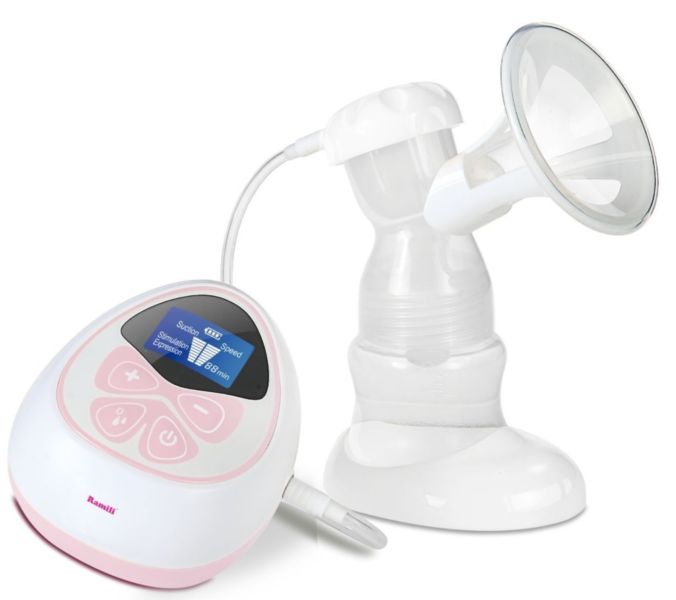
- Net. This is economical, but you need to be close to a source of electricity. These breast pumps are the most powerful.
- The battery allows you to choose the place to express at your discretion. The device requires regular recharging to operate.
Functions
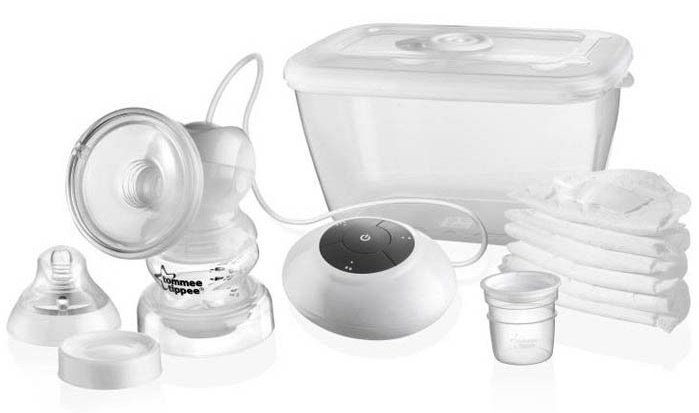
- Two-phase pumping. The devices are equipped with a program that regulates the rhythm of natural feeding. The first phase is stimulation, which imitates the baby's quick but shallow sucking movements.
The milk is coming. The second phase involves the process of pumping. This is a slow and strong sucking. The efficiency and speed of the process is ensured.
- Adjustment of pumping force. This option allows you to select a comfortable operating mode for the device.
- Suctioning from two breasts at the same time. This feature saves time.
- Massager. The mechanism massages the mammary glands and stimulates lactation.
Breast pump equipment

The classic assembly includes a product with a funnel, a milk bottle, and a lid for it.
The set may include:
- feeding bottle;
- mechanical pump handle;
- sealing disc for storing milk;
- electrical unit, adapter;
- bushing for connecting the body to the bottle;
- massage nozzle.
Accessories
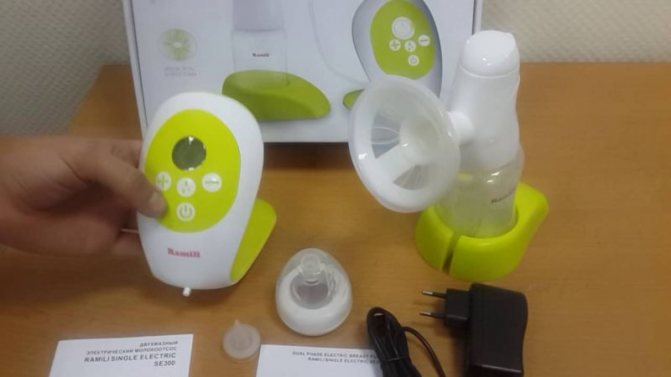
- additional container for storing milk;
- disposable freezer bags;
- funnels of various sizes;
- 2-3 bottles;
- pacifiers from birth, from 3 months;
- container for sterilization;
- cooling gel sachets;
- a bag for storing or carrying the device.
Additionally, the breast pump is equipped with spare parts: membranes, valves, lactation pads.
How often should you pump?
Of course, every woman’s body is unique, as are the needs of babies. However, there are a number of general recommendations regarding pumping frequency:
- If you are afraid of losing milk after childbirth and there is no way to feed your baby regularly, then it is best to stick to this regimen. Empty your breasts for the first time within 6 hours of giving birth (don't be alarmed if you only get a few drops of yellow colostrum). After this, try to express at least once every 2-3 hours. Establishing the night process will be a huge plus.
- If your baby cannot breastfeed for some time, try to stick to the usual schedule. That is, express at exactly the same intervals as you fed the baby.
- If after feeding your baby you feel that your breasts are full and “heavy,” we advise you to express after each feeding until complete relief. This must be done on the first day of alarming symptoms, otherwise, if you do not take the problem seriously, you can get lactostasis.
Remember that if it is not possible to empty your breasts completely, pumping for 5 minutes is better than not pumping at all. Even such a short stimulation of the mammary glands gives the mother’s body a request to increase the production of breast milk.
How long can milk be stored?
Many mothers are interested in questions about how often they can express milk using a breast pump, and how long baby treats can be out of the freezer. If we are talking about a natural product, then there is no need for unnecessary worries. Breast milk has antibacterial and anti-infective properties, so it can be stored:
- about 8 hours without refrigeration at room temperature;
- in the refrigerator 7-8 days.
There is an opinion that several servings of expressed treats for a baby cannot be mixed. But this myth has nothing to do with reality. The main thing is to follow a simple rule: before mixing them together, cool the last portion to the same temperature as the previous one. We also pay attention to this point: breast milk will always separate (after all, it contains both milk fat and other lighter substances). Therefore, this is not at all an indicator of its freshness and quality.
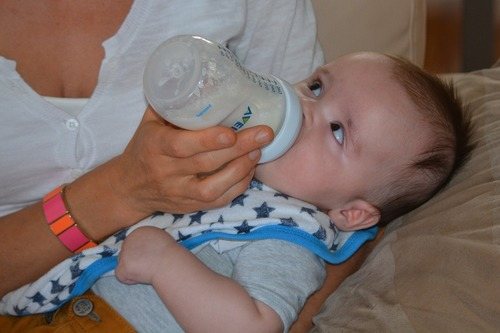
How to get your milk flowing
As you know, it is difficult for babies to suck milk, so it is not surprising that proper pumping takes a lot of time. To speed up the process of expressing with a breast pump, experts recommend moving the body forward a little. But besides this, there are other recommendations:
- If you have not yet established lactation and your baby is eating colostrum, you can drink a glass of warm still water. Warm drinks help improve colostrum flow. It will also be useful to take a warm shower or do a light warming chest massage. By the way, the last manipulation is especially recommended for women with “heavy” breasts in order to prevent the development of lactostasis.
- Looking at photographs of the child also has a good effect. This also stimulates the flow of breast milk.
- You can apply a warm towel to your chest.
- Additionally, you can stimulate your nipples. Hold them between two fingers and gently roll them several times.
Recommendations for pumping
Often nurses are interested in how to properly express breast milk with a breast pump. It's no secret that this process is difficult for many women.
- First you need to wash your hands and breasts.
- Before using the device, carefully read the instructions. The duration of the process of expressing breasts using a breast pump depends on the volume of milk in the mammary glands. Typically it takes 10 to 15 minutes for each breast. If breast milk stops flowing before this time, stimulate this process artificially by continuing to “squeeze” droplets for 2-3 minutes. By the way, experts believe that expressing two breasts has a better effect on the lactation process. They recommend that women who are concerned about this issue express the second breast while the baby drinks a treat from the first.
- Many mothers, both at the beginning and during lactation, develop cracks in their nipples and it turns out that their irritation brings additional discomfort. When using mechanical devices, it is worth lubricating them with vegetable oil.
- To ensure that the breast pump breast shield adheres better to the breast skin, it is recommended to moisten it with a towel.
- It is equally important to choose the correct funnel size. Do not forget that in the process of properly expressing milk using a breast pump, the nipple should not be squeezed.
The funnel is selected correctly if the nipple areola does not fall into the funnel tunnel, and also if the breast remains evenly empty on all sides after pumping. Please note that if a woman has large mammary glands and nipples, then it is better for her to choose the largest breast shield.
Learning to use the Avent breast pump correctly
We have selected a video for you to better familiarize yourself with the process of expressing breast milk with a manual breast pump. You can also see in the video about the features of the Avent device.
Correct use of the device
A relatively inexpensive and easy-to-use model is a manual breast pump. It is no less effective than an electric one, it is convenient to use, easy to disassemble and wash. The device has its advantages and disadvantages.
The advantages of a manual breast pump are that:
- It does not require an additional power source such as a battery or battery to operate.
- It works silently.
- The device must be controlled manually, this allows you to regulate the force of pumping and carry out the procedure absolutely painlessly.
- Hand tools can be disassembled and washed. You can learn how to properly assemble and disassemble the device from the video instructions.
The disadvantages of a mechanical device are that:
- The pumping process takes a long time. More detailed technology can be found in the video.
- In work you need to use the energy of your own hands, so fatigue occurs in your hands and it becomes difficult to use for a long time.
- The kit does not include spare parts, and the main ones may not be strong enough.
Expressing with a manual breast pump usually lasts about half an hour. This device is made of high-quality polypropylene, and the nozzles are made of soft silicone.
Expressing is comfortable thanks to the petal-shaped pad and soft funnel. The kit also includes a bottle, nipple container, lid and milk storage container. The device has a modern design.
The Avent breast pump is easy to use. If you watch a video about using different devices, you will notice that the Avent is the most convenient breast pump. To express milk, you don’t need to constantly lean forward, which is very inconvenient, especially when there were tears after childbirth and you can’t sit, you can take a comfortable position. With this device you can express milk even while reclining. When tilted, milk will not spill out of the bottle, since the device is equipped with a one-way valve-plug that allows milk to pour in, but does not allow it to pour out.
There is a soft pad on the body that stimulates milk production and makes the process of expressing easy and enjoyable. Having mastered the technology of pumping, you can understand that this process is not so difficult. For quick learning, you can watch the video.
Before use, all parts of the device must be sterilized, and each time after use, the breast pump must be disassembled and washed.
Before you start pumping, you need to wash your hands and nipples with soap and dry them. The manufacturer claims that the breast pump is comfortable to use with one hand, but some reviews say differently. Well, those who have enough strength use one hand, and those who do not, work with two.
So, the process of expressing with a manual breast pump consists of the following stages:
- It is necessary to take a comfortable position, preferably such that the body is vertical.
- Before applying the device, you need to slightly stretch the nipple with your fingers.
- You need to carefully insert the breast into the middle of the funnel, so as not to pinch the skin or rub the breast.
- All actions must be performed slowly, otherwise the nipple may be injured. You need to press the breast pump handle lightly and slowly at first and gradually increase the force, choosing the most comfortable level. If you immediately press hard, the skin on the nipple may crack and further manipulation will be very painful.
- At first, the milk will flow very slowly, a few drops at a time, and will gradually splatter.
- To successfully express milk, you need to imitate the rhythm of sucking by rhythmically pressing the handle, holding for a few seconds and pressing again.
- If milk stops coming out of your breasts, it means pumping was successful. Usually the procedure takes no more than half an hour.
After expressing, the device must be sterilized and dried again. The container with milk must be closed, indicate the time of pumping and place it in the refrigerator. You can make the process easier by combining it with feeding. You can learn more about the pumping technique using the video.
How to care for a breast pump during lactation
After purchasing the device, it must be sterilized for 5 minutes in a pan of boiling water or a double boiler. If you have a special sterilizer for bottles, then there is no problem at all.
Every time you finish expressing milk, you need to wash your breast pump. All parts of the device that have contact with the skin of the breast and the milk itself must be thoroughly washed with laundry soap and hot water. Then wait until the parts of the breast pump dry on their own and reassemble the unit.
Expressing with a breast pump is an indispensable manipulation to avoid lactostasis. It may also be justified in some cases that we have described. But still, the best stimulator of your lactation is not a modern manual or electric device, but your child. Apply it to your chest as needed. And if you have decreased breast milk production, practice night feedings on a regular basis.
Malfunctions
No vacuum
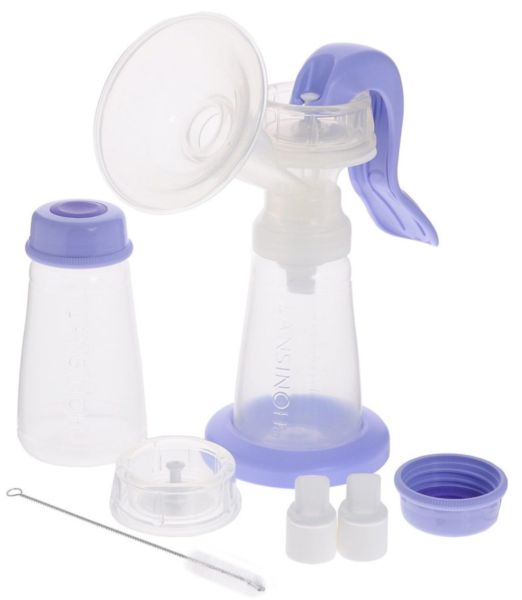
Check the serviceability of the membrane (rubber valve) and whether there is any tearing. If a vacuum appears when pressing on the membrane, replace it with a new part. The second option is a clogged motor.
When milk gets inside the mechanism, performance is affected. The motor should be cleaned of dirt. Check that the device is assembled correctly and the valve is installed so that the silicone pad fits tightly to the chest and body of the device.
Milk is not expressed
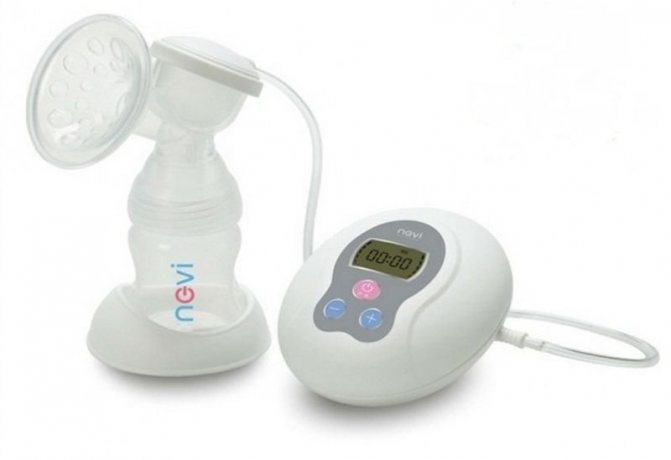
Check the assembly quality of the parts, whether there is a vacuum. Then try the procedure again. At the same time, relax as much as possible.
Painful sensations when expressing

The reason may be the high swing force. Do not use the maximum power of the device. Reduce the speed, in a mechanical device bring the handle to half.
Milk seeps out from under the pad
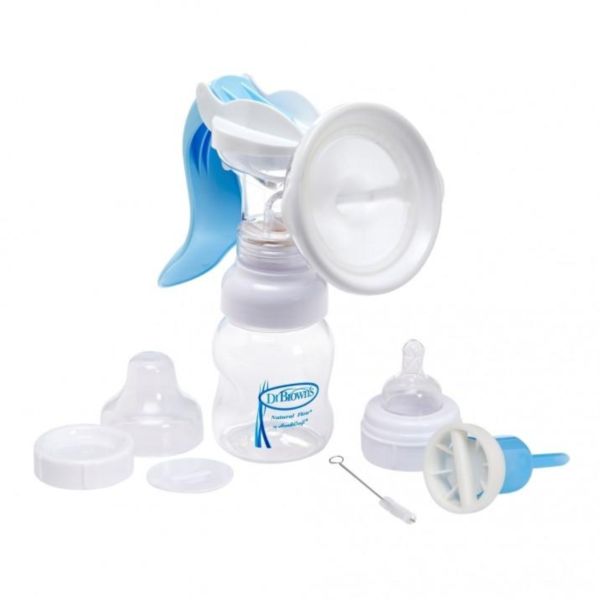
Remove the attachment, wipe the skin dry, and put it on again. Check that the cover is in good contact with the funnel. If a crack is detected during an external inspection, replace the part with a new one.


